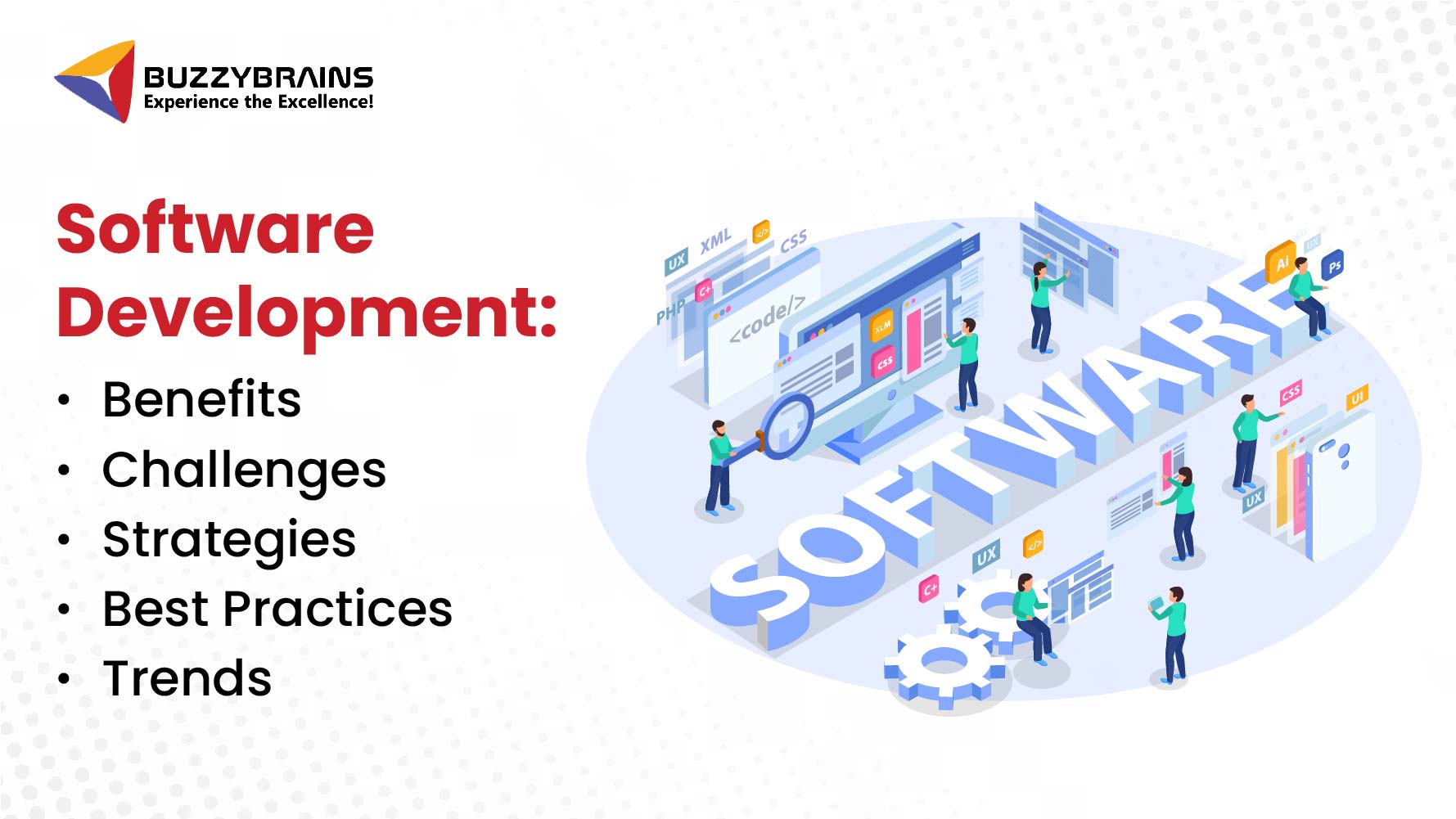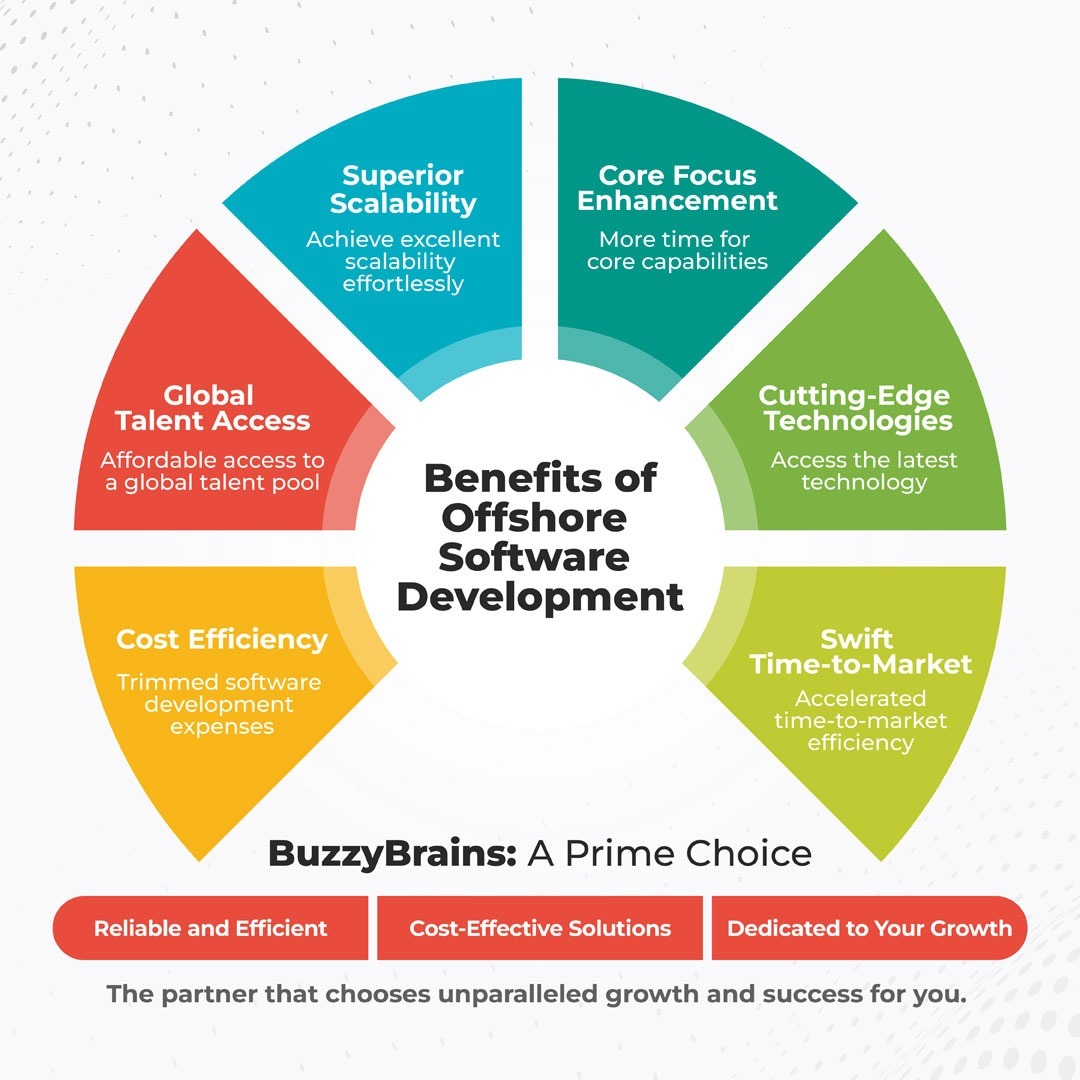Offshore Software Development: Benefits, Challenges, Strategies, Best Practices, and Trends!

- Offshore Software Development
- Offshore Software Development Model
- Benefits of Offshore Software Development
- Offshore Software Development Risks
- Offshore Software Development Statistics
- Offshore Software Development Steps
- Choosing the Right Offshore Software Outsourcing Company
- Top Countries for Offshore Software Development
- Who Should Hire Offshore Developers?
- Offshore Software Development Rates
- Cost to Hire an Offshore Development Team
- How to Manage Offshore Software Development Teams
- Offshore Software Development Trends
- What Does an Offshore Partner Do?
- Offshore Software Development Best Practices
- Reasons to Outsource Development in India
- Collaborating with an Offshore Software Development Provider
- Onshore, Nearshore, and Offshore Software Development Differences
- FAQs about Offshore Software Development
- Conclusion
- Start Building Your Offshore Development Team with BuzzyBrains
Offshore Software Development
Offshore software development is an invaluable resource for organizations aiming to expand their technical prowess or introduce new development projects. Although the inception of offshore software development can be traced back to 1996, when General Motors opened its first IT ODC in India, it was only after the COVID-19 Pandemic that the concept entered mainstream imagination.
In simple words, we can understand offshore software development as a process wherein a company outsources some or all of its software development requirements to an offshore partner in a foreign country. To achieve so, the organization can hire freelance developers or build an entire development team through a dedicated company.
In addition, it is upon businesses if they want to take the help of end-to-end development services or focus on certain processes, such as mobile app development, UI/UX design, web development, etc. Whether it is for a particular project or an ongoing basis, offshore software development is an efficient way to quickly and swiftly scale without hiring and training employees in-house.
The skyrocketing demand for jobs in the software development sector is complemented by increasing market volatility and a shortage of skilled tech workers; thereby, compelling businesses all across the world to adopt revised approaches like offshore software development. In 2021, the offshore software development market reached the USD 526.6 billion threshold and is expected to continue growing.
Now that we have touched upon the basic definition of offshore software development, let us check out its types and functioning.

Offshore Software Development Model
Companies can tailor their offshore software development strategy to their unique requirements by selecting from a number of different models. Some of the models mentioned in the search results are listed below:
Fixed Price Model:
Project scope is defined and a set cost is decided upon for the entire project in the fixed cost model. When project needs are clearly specified and unlikely to change considerably during development, this paradigm is appropriate.
Dedicated Development Team Model:
In this model, the offshore team is tasked to work solely on the client’s project. The client can manage the team directly and has complete control over the offshore team. This paradigm is great for long-term projects.
Time and Material Model:
The client only pays for the actual time and materials used on the project in the time and material model. An hourly or daily rate is used to determine the price. This paradigm is adaptable and allows for modifications to project needs and scope.
Build-Operate-Transfer Model:
Build-Operate-Transfer (BOT) is a form of business engagement model that refers to hiring an offshore development partner in a foreign location that provides a dedicated offshore team. Here, the offshore partner is responsible for recruitment, legal compliance, payroll, accounting, and other operational functions at the start. However, after some time, this offshore team is going to be transferred back to the client & the client will have total control over the team.
Benefits of Offshore Software Development
The offshore software development market is flourishing for a reason. It has multiple benefits. What are they? Let us find out!
- Reduced costs of software development
- Access to a global pool of talent at an affordable rate
- Excellent scalability
- The organization gets more time to focus on core capabilities
- Access to the latest technologies
- Faster time to market
Offshore Software Development Risks
Offshore software development has a lot of undeniable benefits, like the ones we mentioned above. But, if you don’t choose the right offshore partner, you may risk your project in certain ways. What are they? Let us find out!
- Time-zone differences
- Quality assurance Security concerns
- Challenges in technical assessments and selection
- Time and cost overruns
- Intellectual Property risks
- Cultural differences
Offshore Software Development Statistics
Truth be told, it is not enough to make big claims about any phenomenon without demonstrating the right data. So, now that we know the fundamental aspects of offshore software development, let us check out some related statistics.
A quote from the Accelerance Global Software Outsourcing Report 2023 said, ‘In the coming year, outsourcing is predicted to be an antidote for economic woes.’ Likewise, Deloitte’s 2020 Global Outsourcing Survey mentions that outsourcing proved to be a resilient activity amidst the global pandemic challenge. In the report, it was mentioned that cost reduction was the key driver for offshoring (70 percent).
Another important survey is the growing difficulties in hiring skilled technical talents in countries like the USA and the UK. For instance, according to ManpowerGroup, 69 percent of US-based organizations are facing difficulties hiring IT professionals. In the UK, 67 percent of tech leaders are in agreement that tech talent shortage is disrupting the market momentum. Thus, it is understandable for companies in the West to consider novel approaches like outsourcing and ODCs.
Offshore Software Development Steps
Let us now dabble into a very intriguing aspect of the post – the steps involved in offshore software development.
1. Identify Your Requirements – Determine the reason for needing offshore support, the type of expertise you need, and how the offshore team will be working with the core team.
2. Ask for Recommendations – It is always a good idea to learn from others. So, make sure to take advice from people who have worked with an offshore team in the past and seek recommendations.
3. Look for Trusted Publications – While searching online for reliable offshore development services, you cannot rely on any source that props up on the screen. The key is to check for online platforms and review sites with crowdsourced recommendations on dependable and skilled software development providers in your area of interest.
4. Choose Your Preferred Region and Time Zone – The ideal situation is to work with an offshore development team that has some overlap in working hours. An overlap makes it easier for the core team to be available if the offshore team has any questions and vice versa. Besides, in-person feedback provision and direct communication also become easier when there is an overlap in the time zone.
5. Shortlist the Candidates – The fifth step while hiring an offshore software development team is narrowing down your options and choosing between two to three companies to interview.
6. Conduct Interviews – Then, you have to conduct interviews, which are the golden opportunity to ask any questions you might have about the type of work the offshore software service provider has done, how they work with clients, what is their timeline of delivering the project, and more. All such questions can also be followed with a more technical conversation to ensure that the chosen offshore service is well equipped with your tech stack.
7. Sign the Contract – The seventh step is to simply sign the contract with the selected service!
Choosing the Right Offshore Software Outsourcing Company
To choose the right offshore software development company, you have to be mindful of certain qualities. Although, there is no one-size-fits-all rule when it comes to finding your ideal software outsourcing partner, but some qualities you must look out for are –
- Excellent communication and fluency in English
- Small differences in time zones
- Experience in your industry
- Right technological skills
- Ability to meet your standards
- Cost-effectiveness
- Established software development process with time-tested practices and innovative approaches.
Top Countries for Offshore Software Development
Some of the best countries for offshore software development are –
- India
- Nepal
- Ukraine
- China
- Mexico
- Poland
- Argentina
Who Should Hire Offshore Developers?
The contemporary software market is all about dynamism, transformation and evolution. Thus, businesses in the tech field are compelled to constantly update their systems, processes, and technical nitty-gritty to stay ahead of the curve. However, doing so in-house can be a pretty expensive affair, especially if you are a company in the United Kingdom, USA, or any similar Western country. In such a context, hiring offshore software developers becomes important. Some of the indicators that hint you need to dabble into IT offshoring are –
- You are a startup with a restrictive budget
- Your business lacks the ideal tech stack
- You want to scale your team in a cost-efficient manner
- You need to lower your operational costs
- You need specialists with a narrow expertise
- You want to focus on the product
- You want to accelerate the product’s time to market
Offshore Software Development Rates
The cost of offshore software development depends on a range of factors. However, if you consider the location or destination, we can arrive at some numbers.
- India – USD 20 to 50 per hour
- Ukraine – USD 30 to 55 per hour
- Poland – USD 35 to 55 per hour
- Argentina – USD 30 to 55 per hour
Cost to Hire an Offshore Development Team
Apart from the direct destination-based rates, there are other factors that determine the cost of hiring an offshore development team.
1. Technical Complexity – It includes app type, supported platforms, UI/UX requirements, back-end processing, third-party integrations, and more.
2. Project Scope – Offshoring software services is not just limited to building the app. The vendors may also charge extra for QA testing, post-release support, and more.
3. Deadlines – If your project is premised on a tight schedule with zero room for mistakes, then the chosen vendor will have to hire additional resources. Thus, the cost of offshoring automatically increases.
4. Tech Stacks – Complex software applications need a team of developers skilled in various tech stacks. The greater the number of IT experts involved in your project, the higher will be the bill.
How to Manage Offshore Software Development Teams
Offshore software development does not simply end with hiring the vendor. You also need to manage the team. How? By following some simple steps –
- Ensure that you are on the same page as the offshore team
- Agree on tracking tools
- Avoid micromanagement
- Establishing clear processes and practices
- Fostering effective communication
- Regular assessment of performance
Offshore Software Development Trends
Similar to other industries, the offshore development domain is also marked by change and transformation. There are multiple trends encircling the industry. For instance, AL and ML skills are becoming a hot commodity in the global market, including the offshoring realm. Thus, we can expect a boom in AI-related job openings in the offshoring locations in the near future. Likewise, the adoption of Web3 is another trend that is taking over offshoring.
The third trend that can become a major aspect of IT offshoring is stringent cybersecurity practices. Though building great software has always been the core priority of product leaders, it is now being replaced by data security. Thus, offshoring vendors and service providers are expected to buckle up and provide tangible proof of data security and IP protection.
What Does an Offshore Partner Do?
The process of offshoring software development begins by partnering with the right offshore company overseas. The experts hired based on offshoring work full-time and the cost of their services is almost three times lower as compared to employing in-house employees. The usual duties of an offshore software development team are –
- The entire software development testing
- Maintenance
- Quality assurance
- Communication with the client
Offshore Software Development Best Practices
To ensure that you are making the most out of offshoring software development, it is essential to follow some best practices, such as –
- Choose your partner carefully
- Always stay in the loop
- Be transparent about expectations
- Agree on ownership of application architecture
- Communicate friendly
- Encourage shared values
- Reuse components
Reasons to Outsource Development in India
Currently, India is one of the most sought-after destinations when it comes to establishing an Offshore Development Center. The availability of highly-skilled professionals, easy and swift access to the workforce, a culturally diverse and accommodative workforce, lower labor costs, and a comparatively lower cost of living are some of the reasons why India has emerged as the most preferred offshoring center.
Besides, a large chunk of the Indian population speaks English, which further adds to the benefits. Currently, India is known to outsource an array of software services, such as mobile app development, digital marketing, software development, and more.
- Lower labor costs
- Lower operational costs
- Lower cost of living
- Higher technical faculty
- Skilled labor availability
Collaborating with an Offshore Software Development Provider
Collaborating with an offshore software development provider comes with a lot of benefits. The key is to engage in preemptive research and find the right offshore software developer at the right overseas location. The collaboration comes with an array of phenomenal benefits, such as increased scalability, reduced operational costs, access to top-tier technical skills, and more.
Onshore, Nearshore, and Offshore Software Development Differences
| Aspect | Onshore Development | Offshore Development |
| Location | Same country | Faraway overseas country |
| Proximity | Near | Very far |
| Cost | Very expensive | Cost-effective |
| Communication | Very easy | Easy |
| Cultural Similarity | Similar | Very different |
| Time Zone Difference | Similar | Different |
| Travel Accessibility | Very accessible | Have to cross seas and oceans |
| Skill Availability | Costly | Very cost-efficient |
| Project Control | High | Moderate to High |
| Language Barrier | None | None |
| Data Security | Very high | With the right processes, no longer a concern |
| Project Cost Savings | Less | High |
| Time Zone Management | Easy | With the right processes, no longer a concern |
| Flexibility | Less | High |
| Collaboration | Easy | Easy |
| Cultural Exposure | Low | High |
| Team Integration | Swift | Easy |
| Legal and Regulatory Alignment | Easy | Easy |
| Local Market Insight | Excellent insights | Minimal insights |
| Vendor Selection | Easy | Moderate |
| Client Satisfaction | Moderate | High |
FAQs about Offshore Software Development
Q1. Is offshore software development suitable for all types of projects?
Ans. Yes, offshore development is suitable for almost all types of projects.
Q2. How do I ensure effective communication with my offshore development team?
Ans. Some of the ways to ensure effective communication with an offshore development team are –
- Use the right tools
- Be kind and understanding in communication
- Respect one another’s time
Q3. What measures can I take to mitigate risks associated with offshore development?
Ans. Some of the ways to mitigate risks associated with offshore development include –
- Define clear milestones and deadlines
- Track progress regularly
- Establish a clear change management process
Q4. How can I manage time zone differences when working with an offshore team?
Ans. You can manage time zone differences with an offshore company by choosing a location that has some time zone overlaps. Besides, being on the same page in terms of communication tools also helps.
Q5. What tools and technologies are commonly used for remote collaboration in offshore projects?
Ans. Some tools used for remote collaboration are –
- Slack
- Zoom
- Google Meeting and more
Conclusion
So, there we have it, a crisp overview of offshore software development, its benefits, challenges, strategies, and best practices. Currently, the world is moving toward greater globalization efforts, and offshoring IT processes snugly fit into that box. With an array of benefits, offshoring is, a sure-shot solution to become a global prowess in your domain.
Start Building Your Offshore Development Team with BuzzyBrains
Looking for a reliable, cost-effective, and experienced offshoring partner to scale up your business? Look no further than BuzzyBrains. We are here to unlock your growth potential with our proven prowess in software development. Dependable, efficient, and robust, BuzzyBrains is the perfect offshoring partner for all your technical needs.
